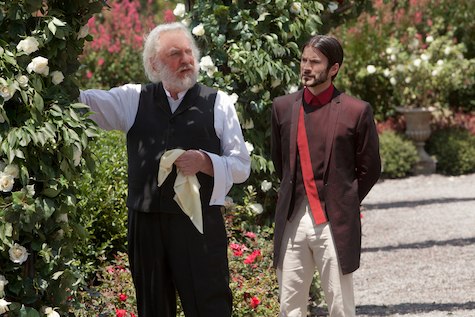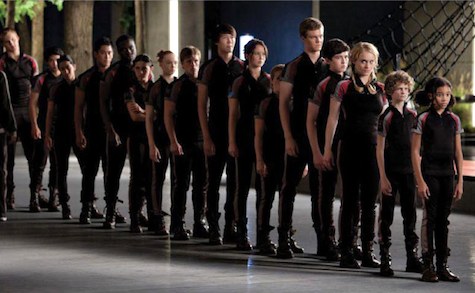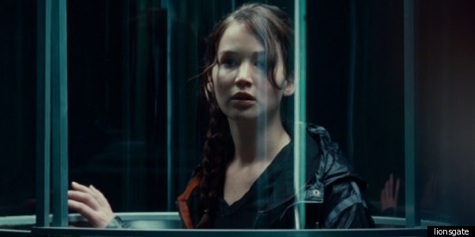There has been a substantial amount of commentary weighed over a statement made by the producer of The Hunger Games, claiming that while the film does not shy away from the violence of the source material, it does not commit “the sins of the Capitol” by making a spectacle of it.
What counts as spectacle might differ in some audience member’s minds, but make no mistake: this film contains plenty of violence. All the same, its success is marked not by the route it choses to go in addressing that violence, but rather in creating a film that sets up its two sequels with alarming clarity and avoids any romanticism where “bread and circuses” are concerned.
It is inevitable bringing up its star progenitor when discussing the film, the book that has devotees from both the Potter and Twilight camps in a tizzy. Fans of the book will delight in certain changes and likely grapple with others. It cannot be denied that the film loses much from not being able to create the first person narrative that the book provides. While it’s impossible to help—successfully imbuing a film with internal narration without resorting to a clumsy voiceover is always a challenge when adapting novels written from a single character’s perspective—bits and pieces of Katniss are swallowed in the shuffle. If an audience member’s sense of the character is solid in their head this might not prove a problem, but one has to wonder how it will affect those who have not read the book before seeing the film.
What the film offers that the book does not are elements of the outside world that readers were not privy to when confined to Katniss’ head. Much more time is spent following Head Gamemaker Seneca Crane and his journey in executing the Games as their head producer, the man who tells them what camera to zoom in, where to drive the show’s “characters.” The moments spent at Hunger Games HQ, in the control room watching Seneca and his team put together a piece of unforgettable television offers us a telling mixture of disgust at the Capitol machine and awkward comic relief. Not awkward because of poor handling, but because in an attempt to process the horrific and public nature of the Games, the audience is given a moment where they can remind themselves that it is, indeed, “only a movie” just as it is “only television” to Capitol citizens. The paradox is both unsettling and oddly humorous.

There is also a measure of set up for the potential film sequels: there are key added scenes involving President Snow (played with masterful calm and cruelty by Donald Sutherland) that show us exactly how Katniss’ actions on camera are affecting the state of political unrest within Panem. We are given more of a sense as to what Haymitch Abernathy—Katniss and Peeta’s mentor from District 12—went through in order to obtain sponsors for Katniss in the Game, hobnobbing and selling their story in order to keep them alive.
The cast is a gift in this film: Jennifer Lawrence is utterly raw in her portrayal of Katniss Everdeen, and she carries the film with the ease of a veteran twice her age (not surprising given break out role in Winter’s Bone). We get impressive work by every young actor thrust into the arena—there’s no danger of camp here, no hamming it up when the camera lights their way, which impresses the seriousness of the Games on you from the very start. Elizabeth Banks provides some much needed comedy by way of Effie Trinket, her clucking and scolding proving every bit as ridiculous on film as it is on the page. Josh Hutcherson gives a startling turn as Peeta Mellark, in that he’s so honestly precious, you can’t help but fall in love with him a little.
But the place where this film really shines is in the complete absence of Hollywood glamour. The opening of the film, the introduction of Katniss’ district—essentially her entire world—is full of dirt and mud, awash in dull colors, and populated with worn and fearful faces. As a result, the arrival at the Capitol, cluttered with technology and gleaming from every corner, feels like a slap in the face. It is perhaps the place in the film where the audience is most capable of connecting with Katniss, this lurch from wood and linen and coal to a train car swathed in blue velvet and silver. Jennifer Lawrence spends the majority of the film in practically no makeup at all. Every freckle on her face is visible to the world, and not one smudge of eyeliner graces her lashline at home or while the Games are in progress. The reality of appearance, down to the caked effect of Effie’s pink and green visage and the impracticality of her high-heeled walk, gives the film a lack of polish that immerses you entirely. The shooting style adds to the effect, unbalanced and often training over a character’s shoulder like you’re peeking out from behind them (though it can be a little nauseating at times, if you’re prone to that sort of thing).

This lack of polish translates to the violence as well. Rather than highly choreographed sequences full of clever camera work, every fight feels like a mad rush free-for-all, children launching at each other with whatever they can find on hand. In that particular way, there is nothing about it to denote spectacle. It’s uncomfortable to watch because the violence is more intimate, designed to tap into your own senses so that you can picture yourself in the position of a tribute. It’s at that point that the film’s distance from Katniss’ perspective is preferable because the true work of the arena becomes clear: it is an actual war, staged with children and fought on a small scale.
The ending is utterly unsatisfying in the exact same manner that the book is. Unlike so many trilogies, the first chapter of the Hunger Games saga leaves everyone with the clear knowledge the fight has only just begun, and pauses on the brink. The film doesn’t shy away from this same ending, and due credit must be given there as well; most studios would not have taken the risk, but as the final shot fades to black, the audience is forced to leave unsettled rather than elated. One can only hope that the move pays off for them in the box office, and the other two films are released in quick succession.
While no movie is ever capable of adapting a book with any measure of exactitude, The Hunger Games is wonderfully effective as a summation of the explorations found in Suzanne Collins’ novel. The next film better get here in a hurry.
Emmet Asher-Perrin was shocked that a few people at her midnight showing had clearly not read the book beforehand. Man, were they surprised. You can bug her on Twitter and read more of her work here and elsewhere.










